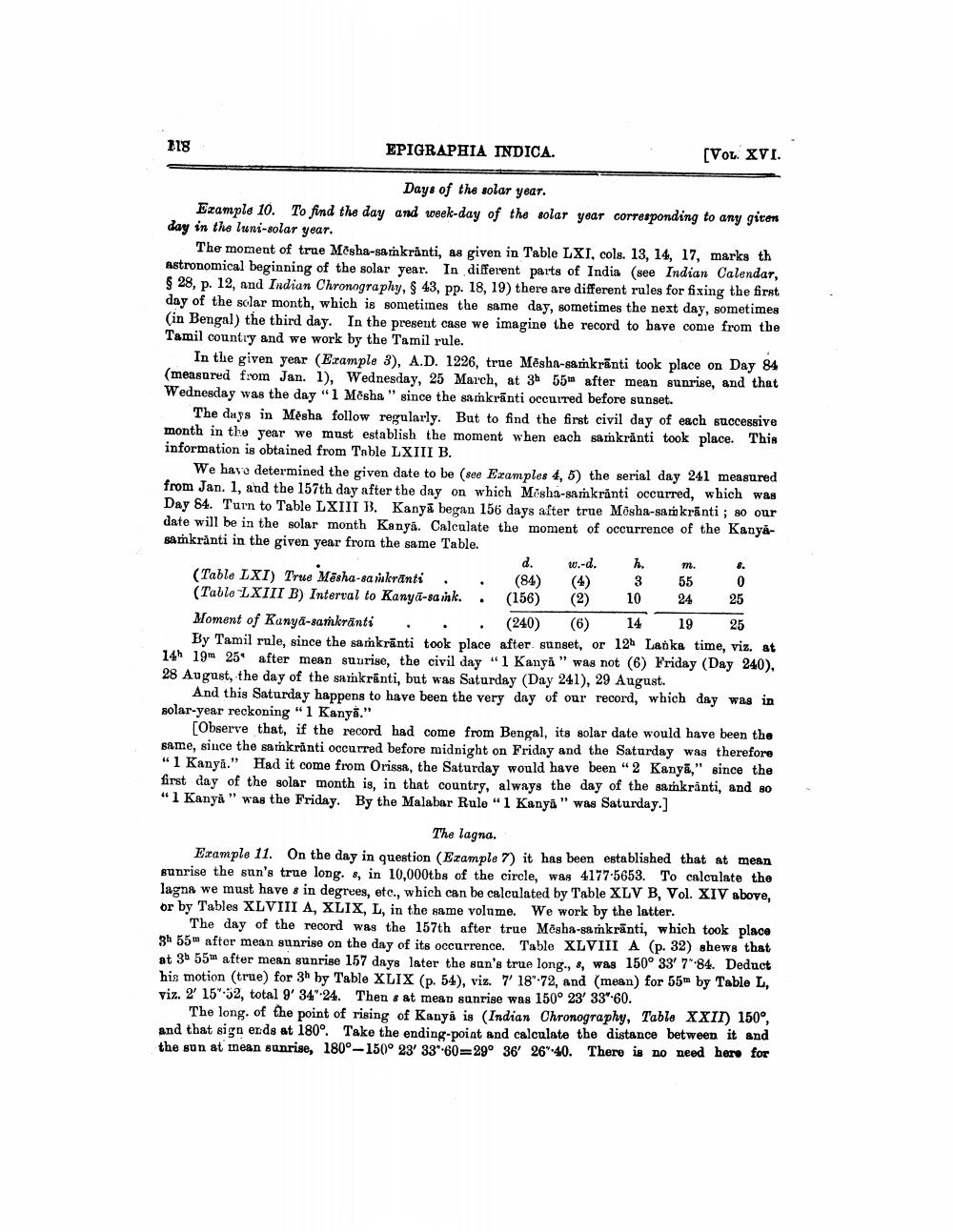________________
118
EPIGRAPHIA INDICA.
[VOL. XVI.
Days of the solar year. Example 10. To find the day and week-day of the solar year corresponding to any given day in the luni-solar year.
The moment of true Mesha-sankranti, as given in Table LXI, cols. 13, 14, 17, marks th astronomical beginning of the solar year. In different parts of India (see Indian Calendar, $ 28, p. 12, and Indian Chronography, $ 43, pp. 18, 19) there are different rules for fixing the first day of the solar month, which is sometimes the same day, sometimes the next day, sometimes (in Bengal) the third day. In the present case we imagine the record to bave come from the Tamil country and we work by the Tamil rule.
In the given year (Example 3), A.D. 1226, true Mēsha-samkrānti took place on Day 84 (measured from Jan. 1), Wednesday, 25 March, at 3h 55 after mean sunrise, and that Wednesday was the day "1 Mosha" since the samkrānti occurred before sunset.
The days in Mesha follow regularly. But to find the first civil day of each successive month in the year we must establish the moment when each samkrinti took place. This information is obtained from Table LXIII B.
We have determined the given date to be see Examples 4, 5) the serial day 241 measured from Jan. 1, and the 157th day after the day on which Misha-sankranti occurred, which was Day 84. Turn to Table LXIII B. Kanyā began 156 days after true Mosha-sam krānti ; 80 our date will be in the solar month Kanya. Calculate the moment of occurrence of the Kanyasamkranti in the given year from the same Table.
(Table LXI) True Mēsha-samkrānti . . (84) (4) 3 55 0 (Table LXIII B) Interval to Kanya-saik. . (156) (2) 10 24 25 Moment of Kunya-sankranti . . . (240) (6) 14 19 2 5
By Tamil rule, since the samkranti took place after sunset, or 12 Lanka time, viz. at 14h 19m 25. after mean suurise, the civil day "1 Kanya " was not (6) Friday (Day 240), 28 August, the day of the sankranti, but was Saturday (Day 241), 29 August.
And this Saturday happens to have been the very day of our record, which day was in solar-year reckoning "1 Kanya."
[Observe that, if the record had come from Bengal, its solar date would have been the same, since the samnkrinti occurred before midnight on Friday and the Saturday was therefore "1 Kanya." Had it come from Orissa, the Saturday would have been “2 Kanyā," since the first day of the solar month is, in that country, always the day of the samkrinti, and so "1 Kanya " was the Friday. By the Malabar Rule" 1 Kanya" was Saturday.]
The lagna. Example 11. On the day in question (Example 7) it has been established that at mean sunrise the sun's true long. s, in 10,000tbs of the circle, was 4177-5653. To calculate the lagna we must have s in degrees, etc., which can be calculated by Table XLV B, Vol. XIV above, or by Tables XLVIII A, XLIX, L, in the same volume. We work by the latter.
The day of the record was the 157th after true Mēsha-sankranti, which took place 3h 55m after mean sunrise on the day of its occurrence. Table XLVIII A (p. 32) shews that at 3h 55m after mean sunrise 157 days later the san's true long., &, was 150° 33' 7"84. Deduct his motion (true) for 3h by Table XLIX (p. 54), viz. 7' 1872, and (mean) for 55m by Table L, viz. 2 15952, total 9' 34"-24. Then 8 at mean sunrise was 150° 23' 33"60.
The long. of the point of rising of Kanya is (Indian Chronography, Table XXII) 150o, and that sign er:ds at 180°. Take the ending-point and calculate the distance between it and the sun at mean sunrise, 180°-150° 23' 33"-60=29° 36' 26-40. There is no need here for




